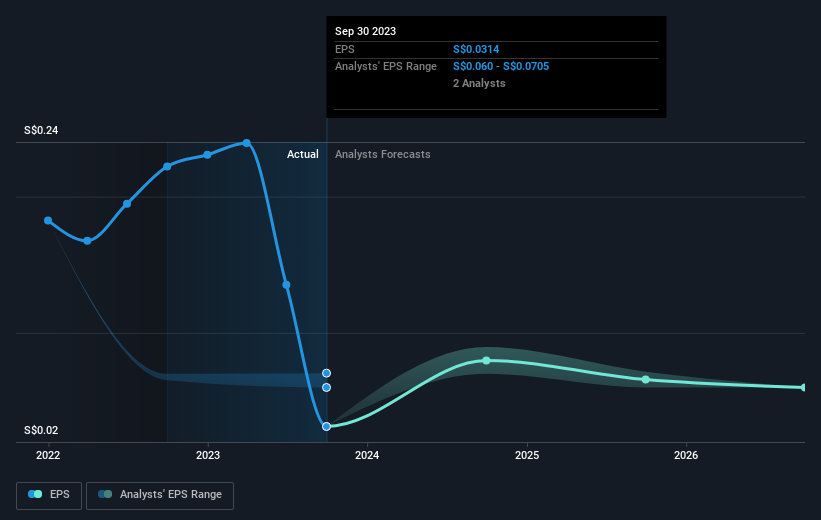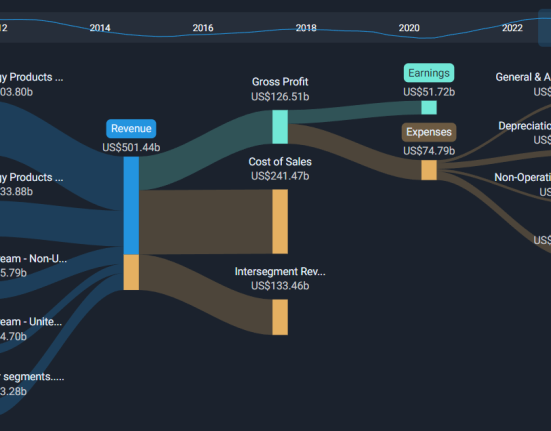We think intelligent long term investing is the way to go. But along the way some stocks are going to perform badly. For example, after five long years the Frasers Property Limited (SGX:TQ5) share price is a whole 57% lower. That’s not a lot of fun for true believers. The falls have accelerated recently, with the share price down 15% in the last three months.
After losing 6.5% this past week, it’s worth investigating the company’s fundamentals to see what we can infer from past performance.
Check out our latest analysis for Frasers Property
To quote Buffett, ‘Ships will sail around the world but the Flat Earth Society will flourish. There will continue to be wide discrepancies between price and value in the marketplace…’ One flawed but reasonable way to assess how sentiment around a company has changed is to compare the earnings per share (EPS) with the share price.
During the five years over which the share price declined, Frasers Property’s earnings per share (EPS) dropped by 33% each year. The share price decline of 16% per year isn’t as bad as the EPS decline. So investors might expect EPS to bounce back — or they may have previously foreseen the EPS decline.
The company’s earnings per share (over time) is depicted in the image below (click to see the exact numbers).
It might be well worthwhile taking a look at our free report on Frasers Property’s earnings, revenue and cash flow.
What About Dividends?
It is important to consider the total shareholder return, as well as the share price return, for any given stock. Whereas the share price return only reflects the change in the share price, the TSR includes the value of dividends (assuming they were reinvested) and the benefit of any discounted capital raising or spin-off. Arguably, the TSR gives a more comprehensive picture of the return generated by a stock. As it happens, Frasers Property’s TSR for the last 5 years was -51%, which exceeds the share price return mentioned earlier. This is largely a result of its dividend payments!
A Different Perspective
While the broader market lost about 3.5% in the twelve months, Frasers Property shareholders did even worse, losing 6.2% (even including dividends). Having said that, it’s inevitable that some stocks will be oversold in a falling market. The key is to keep your eyes on the fundamental developments. Unfortunately, longer term shareholders are suffering worse, given the loss of 9% doled out over the last five years. We’d need to see some sustained improvements in the key metrics before we could muster much enthusiasm. It’s always interesting to track share price performance over the longer term. But to understand Frasers Property better, we need to consider many other factors. Case in point: We’ve spotted 4 warning signs for Frasers Property you should be aware of, and 1 of them is potentially serious.
If you are like me, then you will not want to miss this free list of growing companies that insiders are buying.
Please note, the market returns quoted in this article reflect the market weighted average returns of stocks that currently trade on Singaporean exchanges.
Have feedback on this article? Concerned about the content? Get in touch with us directly. Alternatively, email editorial-team (at) simplywallst.com.
This article by Simply Wall St is general in nature. We provide commentary based on historical data and analyst forecasts only using an unbiased methodology and our articles are not intended to be financial advice. It does not constitute a recommendation to buy or sell any stock, and does not take account of your objectives, or your financial situation. We aim to bring you long-term focused analysis driven by fundamental data. Note that our analysis may not factor in the latest price-sensitive company announcements or qualitative material. Simply Wall St has no position in any stocks mentioned.







